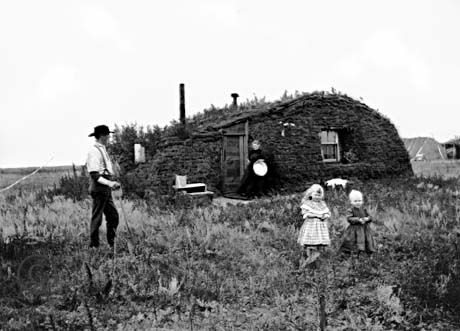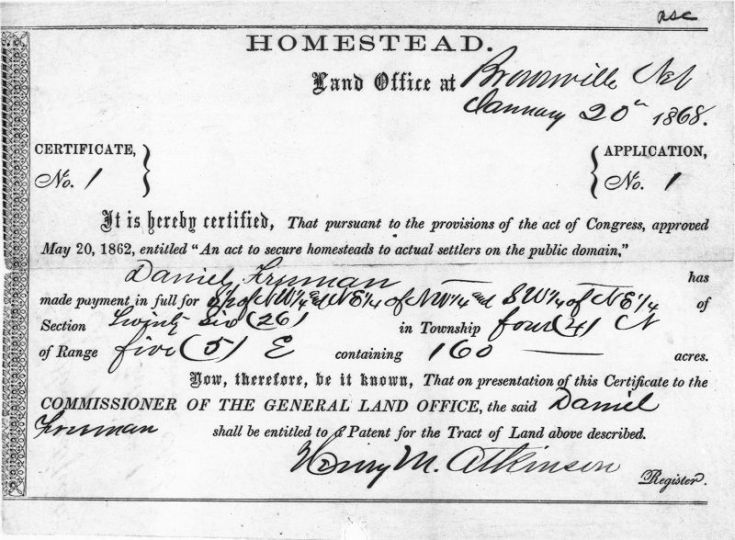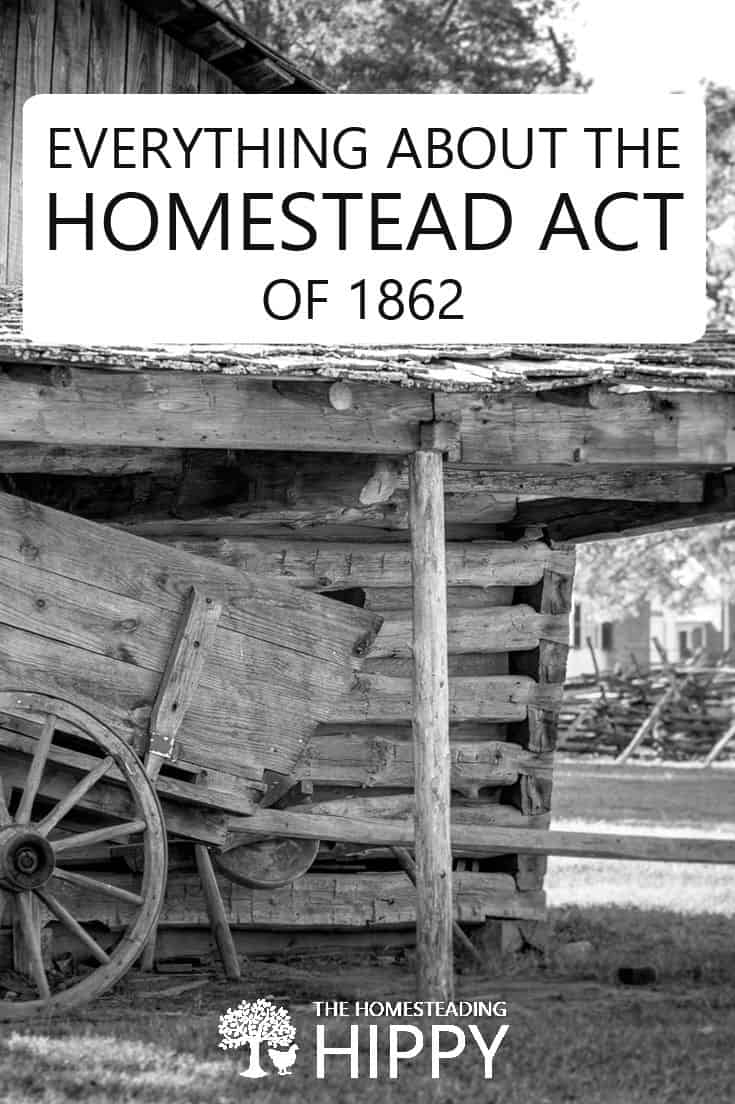In the midst of the turmoil of the early part of the American Civil War after the fall of Fort Sumter on April 13, 1861, recently elected President Lincoln addressed Congress to explain several actions that he had authorized without congressional approval in an attempt to have them approved after the fact. In this speech, the president also makes his first explanation of the war.
This is essentially a people’s contest. On the side of the Union it is a struggle for maintaining in the world that form […] of government whose leading object is to elevate the condition of men; to lift artificial weights from all shoulders; to clear the paths of laudable pursuit for all; to afford all an unfettered start and a fair chance in the race of life.
Abraham Lincoln

Quick Facts
| Who was eligible? | U.S. citizens, free slaves, single women |
| Age requirement? | Over 21 years old. |
| Races? | People of all races were eligible. |
| Amount of land was distributed | 270mn acres (=109mn hectares) |
The Homestead Act was passed by the House of Representatives on February 28th 1862 with a vote of 107 for and 16 against. In a subsequent vote, the Act was passed by the Senate on May 6th 1862 with a vote of 33 to 7.
The Homestead Act was signed by President Abraham Lincoln on the 20th of May 1862. This Civil War-era act is considered to be one of the most important and influential acts ever passed in the United States.
This single most important piece of legislation heralded the expansion and development of the western regions. With this act in place, it permitted any citizen, women, immigrants and former slaves, in fact, anyone that had not borne arms against the state, to become landowners for very little money.
Before the Act
Never before had the government offered to virtually give away such a huge quantity of land.
Since the American war of Independence, the allocation of any unsettled land outside the original 13 colonies was problematic. Measurement and pricing of land were not standardized, resulting in vast differences and inequalities.
The original method of establishing boundaries from geographical landmarks resulted in many conflicts due to claims of borders overlapping.
An attempt to standardize Federal land surveys to ease boundary conflicts by using astronomical data was made in 1785 with Land Ordinance.
The territory that had not been settled was divided into a square called a township that measured 6 miles and subsequently divided into 36 areas which each measured 1 mile or 640 acres. Each area was available to be purchased from the government at a price of $1 per acre.
The total cost of $640 alongside the massive cost or labor required to clear such a large plot put them far out of the reach of many people, consequently, as a method of generating income for the government it was fine but it did not encourage a mass regeneration.
By 1800, the lot size was halved to 320 acres, and purchasers were allowed to pay for them by means of 4 installments, however, the price remained fixed at $1.25 per acre until 1954. At this time, federal legislation established a graduated scale of land prices to reflect the desirability of the lot.
At the same time, plots that were not as desirable and had been on the market for 30 years were reduced to 12 ½ cents per acre. Soon after this, land in the Oregon Territory was made available with extraordinary bonuses to veterans. This made homesteading an option for some, but for most, it was still not affordable.
With new demographics, and the changing social climate of early 19th-century America, the evolving economy created popular pressure to change land allocation policy.
In the 1830s and 1840s, with the price of cotton, wheat and corn rising more affluent eastern farmers were able to buy out smaller ventures to increase their land and crops. These displace farmers looked to move to the west, especially areas that were not forested as this was more affordable.
Prior to the American war with Mexico, people demanded settlement as a right, and argued that they should be allowed to settle and pay for the land later from their profits. This was opposed as it was felt that more would be encouraged to settle and this would greatly reduce the cheap labor base that the emerging factories relied upon.
With emerging opportunities and growing prosperity immigrants looking to develop a new way of life were attracted to the western regions of America.
As the infrastructure development gained pace across the country the western regions became much less reliant on goods flowing through the New Orleans Harbor. Also, at this time, the repeal of the Corn Laws in England allowed a greater opportunity for American agriculture.
Even with these developments and the efforts of many to improve homesteading laws, there was still significant opposition.
Reduction of the pool of cheap labor force was a strong factor alongside the fear that the western states would become populated by increasing numbers of small farmers who were opposed to slavery.
Although settlers were permitted to settle and pay later, the House of Representatives passed Homestead legislation on three separate occasions, on each occasion the legislation was not passed by the Senate.
In 1860 a homestead bill was passed by the House of Representatives and the Senate that allocated Federal grants for land for those wishing to settle in the west. Unfortunately, this act was vetoed by President Buchanan.
With the Civil War, the southern states withdrew from the union, and hence removed the slavery issue from the opposition permitting the homesteading act to become law in 1862.
How Did the Act Work?
The new act provided a simplified three-stage homestead acquisition process: file an application, improve the land, and file for a deed of title.
The potential homesteader, any U.S or intended U.S citizen was able to make a claim for 160 acres of surveyed government land from the General Land Office in Washington by paying $18 for filing the claim.
A fee of $10 was payable to permit a temporary claim with a $2 commission that was required to be paid to the land agent and $6 to receive an official patent.
There was another option to buy the land from the government for $1.25 per acre when it could be proved that someone had been resident on the land for 6 months.
Additional requirements were that the claimant must be the head of the household or at least 21 years old, and able to certify that they had not borne arms against America. There was also a requirement that they built a house on the property and farmed the land and made improvements over a five-year period.
After the Civil War soldiers were able to participate in the homesteader scheme, and were able to subtract the years served from the 5-year residency period.

Who Was the First?
Whilst at a New Year’s Eve party in Nebraska, Daniel Freeman met local land officials, and somehow persuaded them to open the local land office shortly after midnight. Hence, on January 1st, 1863 Daniel was able to file a land claim that would enable him to be the first to take advantage of the Homestead Act.
On that day, another 417 people also placed a claim for land followed by many more in the following days, leading to this unused land being rapidly populated, and to the building of schools, churches, and even entire towns.
However, at this time, the Civil war was still in progress, and 11 states had already withdrawn from the union, ensuring that this legislation continued to have regional, racial and political overtones for some time.
Today the location of this first homestead created from the 1862 act in Nebraska is celebrated by the Homestead National Monument of America which is situated outside Beatrice, Nebraska.
Problems With the Act
Although there were many people who grasped the opportunity that was offered by the act, in reality, there was a limited number of people who had the resources to be able to build a house and ancillary buildings that were required by an operational farm.
Over six million acres of land had been claimed by 1876, however over 60% of claims filed on this huge quantity of land were not seen through to completion by the homesteaders.
There were a number of loopholes in the act that meant that there was a significant amount of fraud surrounding the act.
The Act specified that the dimensions of the dwelling to be built should be 12 × 14. Unfortunately, it did not specify whether the 12x 14 should be feet or inches. It was, therefore, possible to build a house 12 inches by 14 inches and still satisfy the terms of the act.
The General Land office was overwhelmed by the response to the act, and was not able to fund sufficient investigators for the local offices to verify the claims that were being made, this made it easy for fraudulent claims to be accepted and awarded with little fear of repercussions.
The investigators that were employed were paid a very low wage, leaving them susceptible to bribery. Land speculators were able to pay people to make false claims on their behalf with little chance of being discovered.
Congress attempted to modify the act to prevent some fraud, but unfortunately, these efforts only succeeded in compounding the problems.
Large quantities of the land were acquired by the railroads, miners, lumbermen and cattlemen. Consequently, when the Railroads Act became law in 1869 it wasn’t long before the frontier was spanned by a transcontinental railway.
Whilst the new railroad was beneficial for the homesteaders in that with this easy transport link, it became easier to acquire all the necessary supplies required by a homestead from tools, and barbed wire to houses.
This helped to reduce some hardships encountered in the early days. However, the railroads were also able to lure new immigrants westward where they were able to sell off any excess land to them at inflated prices.
Who Benefited From the Act?
The Homestead Act it significantly accelerated the settlement of U.S. western territory by allowing any American or intended citizen, including freed slaves, to put in a claim for up to 160 free acres of federal land.
It allowed immigrants from many areas of Europe who were suffering hard times to grasp the opportunities that this act provided to forge a new homesteader lifestyle for themselves and their families in the land of the free.
Who Suffered Due to the Act?
Without a doubt, it was the Native American Indians that suffered most from the Homestead Act of 1862. Between 1840 and 1849 the population of America rose by close to 46 million people. With the insatiable demand for land by the Europeans and American settlers as they swept into the west, the Native American Indians became increasingly threatened.
This invasion of the traditional hunting grounds took away much of the Natives ability to survive and resulted in many bloody conflicts between the settlers and the Native Americans as they tried to retaliate. Many of the Native Americans died of starvation and disease brought to the country by the European settlers.
With large quantities of Europeans traveling across a strange country with no help or support, it is no wonder that many perished along the way. Starvation, thirst, Indians and severe weather conditions alongside opportunist bandits all took their toll on this huge migrant movement.
As the demand for land continued to grow the Native Indian tribes were in the way and in danger of slowing the development they were relentlessly pushed further west their customs and traditions were almost eradicated.
The more educated Europeans found it easy to trick the Native Americans into signing illegal treaties that gave away their land. They were often bribed, but were often willing as they were encouraged that this would help them to convert to a European lifestyle.
The Native Americans thought that by pleasing the Europeans, they would be left alone and free to carry on living as they had before. Unfortunately, however, these treaties were acquired legally or illegally it gave the government the power to force them away from their lands, and onto reservations.
There were no free American Indians. By 1887 they had all been placed on reservations.
In the late 1870s and early 1900s, large quantities of land were still in demand, and the Indian reservations were large. In an attempt to free up some of this land the government changed its policy in homing the Native Americans in reservations.
The Dawes Act passed by congress in 1887 gave the right for Native Americans on reservations to have individual farms. This act freed up the land on the Indian reservations for settlers.
Whilst the opportunity of virtually free land was welcomed by huge numbers of people, the viability or success of these homesteaders really depended on where the land was. Many suffered from water shortages, severe weather and plagues of insects that devastated their crops.
For land that was situated on open plains, there were few trees to be able to build a house, forcing many to use sod as a construction material. The limited water and fuel supplies meant that simple tasks of cooking and heating proved to be difficult.
Ironically, the smaller size of 160 was perfectly sufficient for a farmer in eastern areas, however, on the dry plains of some western areas it was not enough to sustain sufficient agriculture. In addition to this, the prairies with a limited source of natural vegetation proved to be difficult areas to raise livestock.
Consequently, 60% of the homesteaders were unable to survive for the 5-year period and vacated the plot before the conditions of the claim could be validated.
When Did the Act Finish?
With the introduction of the Taylor Grazing Act by President Franklin D. Roosevelt in 1934, the end of the Homesteading allocation of vacant land under the Homestead Act of 1862 was virtually at an end. However, last person to receive land under this Act was in Alaska in 1988.
The act raised the question as to if the policy of allocating land to many farmers with such small plots was an effective way of controlling the land. The feeling was that this policy did not take into account the needs of the stock farmers on the Great Plains.
The grazing act recognized that the Homestead Act did not take into account the peculiar geographical and climatic conditions of the west. It had reduced the amount of grazing available for livestock, making it difficult for large scale livestock farming, which was vital to the economy.
Between1860 and 1880, the number of cattle on the plains increased from 130,000 to 4.5 million, an indication as to just how important livestock was in the country.
The purpose of the act was to establish grazing districts that would be regulated and controlled. This would have the effect of improving the land by preventing soil deterioration by overgrazing.
Much of the public land that had not been taken by homesteaders at this time was exceedingly poor quality, and was not capable of providing a sustainable existence.
With the passing of the Federal Land Policy and Management Act in 1976, the Homestead Act was repealed. This act declared all lands that were still publicly owned should remain under Federal ownership and that this land should be controlled and managed by the Bureau of Land Management.
The Consequence of the Act
Does this mean that the Homestead Act was not successful?
There were certainly many problems with how this act was worded and implemented, leading to large-scale fraud and profiteering. However, overall, it did create unprecedented development in the west. Around 270mn acres were offered/sold in total through the Act.
Would this expansion have been as dynamic or widespread without the Act? Would slaves have been encouraged or even permitted to own land without this Act?
Can this act be declared an important milestone in eroding the widespread racial inequalities when it had such a devastating effect on the Native American Indians? According to Britannica thousands of ex-slaves benefited from it, however the whites typically had more access to it than blacks and Native Americans.
In 1962 President John F. Kennedy said in a message to congress relating to conservation that the Homestead Act was, “probably the single greatest stimulus to national development ever enacted.”
Who was the last person to claim land under the act?
The Homestead Act was still active in Alaska until 1986. A homestead claim was filed by a Californian named Kenneth Deardorff in 1974. This Vietnam veteran filed a claim on an 80-acre plot of land that was on the Stony River in the southwestern region of Alaska.
Deardorff finalized his claim in 1988 after living and working on this plot for more than a decade. This made Kenneth Deardorff the last person to claim and receive a title to land under this so important Civil War-era act.


Three years ago, I bought an off-grid Cortijo in a small valley in the Andalucian mountains. Although, perhaps the lifestyle is in my genes as my grandfather and his four brothers were Homesteaders in Alberta Canada in the 1900s.
The mountains of Spain are a difficult place to grow many of the flowers that I was used to in the UK. However, veggies grow well year-round. Peppers, tomatoes, potatoes, lettuce, cucumber, melons, and chard all fare well in the Mediterranean climate. Almond trees provide me with a cash crop of around 1 ton while still retaining some to make almond milk and flour.
Meet the rest of the Homesteading Hippy team here.
